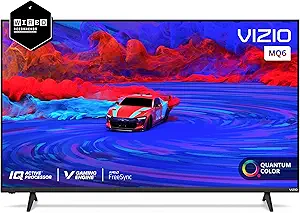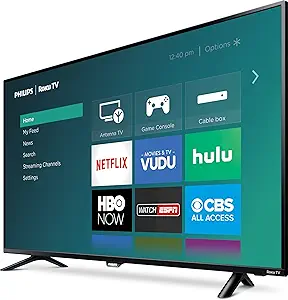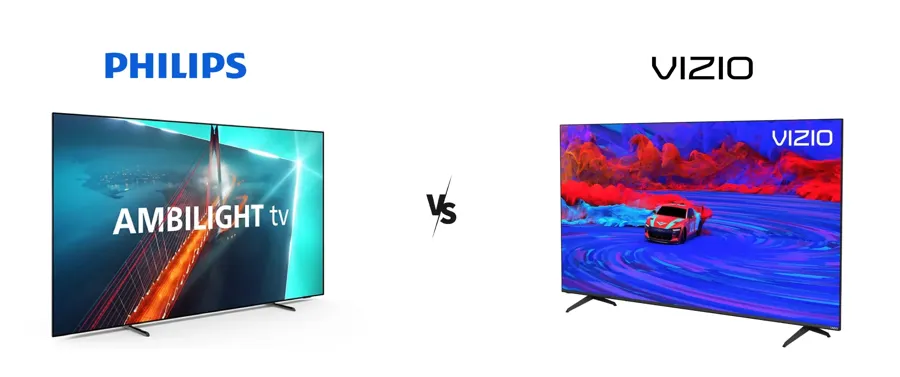
Vizio and Philips both offer a range of TVs, but their focus areas and strengths differ significantly. Vizio is known for affordability, strong HDR performance, and Quantum Dot technology, making it a solid choice for those seeking bright, contrast-rich displays at a lower price point. In contrast, Philips takes a more premium approach, offering OLED models, gaming-focused displays, and a stronger smart TV experience with Google TV and Roku TV.
This comparison breaks down lineups, picture quality, design, sound, smart features, affordability, and more, helping you decide which brand suits your needs best.
Let’s start by examining each brand’s lineup and how their models stack up.
Lineups
Vizio and Philips both offer TVs across different price points, but their lineups follow distinct strategies. Vizio has scaled back its TV releases, focusing on a few Quantum Dot and LED models, while Philips provides a broader global lineup—but with fewer advanced models in the U.S.
Vizio’s current lineup is smaller than in past years, with fewer new releases and a reliance on older models. While Vizio once dominated the value-TV space, their slow release cycle means many of their models are harder to find in 2025.
Philips offers a wider range globally, but its U.S. lineup is more limited, with fewer high-end options. While Philips’ best OLED TVs with Ambilight are available in Europe, they are not part of the U.S. lineup. Instead, the U.S. market gets more mid-range and budget-friendly models, likely reflecting different consumer demands.
Vizio TV Lineup
Premium: Quantum Pro Series – Best for HDR and gaming with full-array local dimming and strong brightness.
Mid-Range: Quantum Series, M-Series – Good balance of price and performance with Quantum Dot technology.
Budget: V-Series – Basic 4K LED option with SmartCast for casual users.
Philips TV Lineup
Premium: OLED Series, Mini LED Series – High-end picture quality with deep contrast and Ambilight lighting.
Mid-Range: QLED 7900 & 7600 Series – Vibrant colors, smooth motion, and 144Hz gaming support.
Budget: 6600 & 6000 Series – Affordable 4K LED with Roku TV or Google TV for easy streaming.
Affordability
Affordability is about how cheap a brand’s TVs are across different price categories. Vizio consistently offers lower prices, while Philips tends to be slightly more expensive, especially in mid-range and premium models.
Premium Class (Vizio Quantum Pro vs. Philips OLED Series)
Vizio’s Quantum Pro series is one of the more affordable high-brightness QLED options, with 65-inch models starting at around $1,299 and 75-inch models at around $1,799.
Philips OLED models tend to be more expensive, with 65-inch models starting at $1,499+ and 75-inch models exceeding $2,000. The higher price is due to OLED technology, which provides perfect blacks and excellent contrast.
Mid-Range Class (Vizio Quantum Series vs. Philips 7900 & 7600 Series)
Vizio’s Quantum Series is one of the more budget-friendly QLED options, with a 55-inch model costing around $499 and a 65-inch model at $699.
Philips’ 7900 and 7600 Series are slightly more expensive, with a 55-inch starting at around $599 and 65-inch models at $799 or more. This price increase comes from better smart TV features, such as Google TV and Roku TV integration.
Budget Class (Vizio 4K Series vs. Philips 6600 & 6000 Series)
Vizio’s 4K Series is priced competitively, with 43-inch models starting at $299 and 55-inch models at around $399.
Philips’ 6600 and 6000 Series tend to cost slightly more, with 43-inch models starting at $329 and 55-inch models at $429. While Philips’ models offer a smoother smart TV experience with Roku TV, the price difference is minimal.
🔹Affordability Summary
Picture Quality
Top-Rated Picture Quality Brands
A TV’s picture quality depends on contrast, black levels, color accuracy, HDR tone mapping, and motion handling. Some models focus on deep blacks and high contrast, while others prioritize color vibrancy and HDR impact. Here’s how Vizio and Philips compare across different price categories.
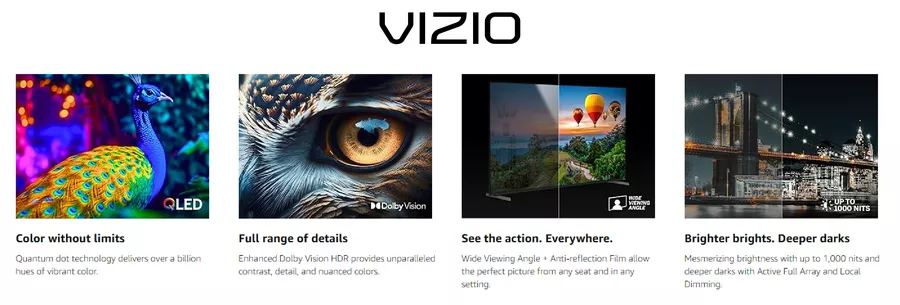
Premium Class (Vizio Quantum Pro vs. Philips OLED Series)
Vizio’s Quantum Pro series delivers good contrast and vibrant colors but struggles with deep black levels due to its VA panel. Local dimming improves contrast, but blooming can occur around bright objects in dark scenes. HDR performance is strong, though motion handling can sometimes feel overprocessed.
Philips OLED models offer pixel-level dimming for perfect blacks and outstanding contrast, creating more natural depth in dark scenes and eliminating blooming. HDR tone mapping is more precise, delivering a refined and cinematic look. Motion handling can be slightly softer compared to Vizio’s stronger motion interpolation settings.
Mid-Range Class (Vizio Quantum Series vs. Philips 7900 & 7600 Series)
Vizio’s Quantum Series features QLED panels with solid color accuracy and strong HDR highlights, but limited local dimming reduces contrast in dark scenes. Motion can appear slightly stuttery, especially in fast-moving content.
Philips 7900 and 7600 models also use QLED technology, but local dimming is even more limited. However, the 7600 Series supports a 144Hz refresh rate, resulting in smoother motion and reduced stutter. While HDR colors aren’t as bright as Vizio’s, Philips maintains better color accuracy and natural tone balance.
Budget Class (Vizio 4K Series vs. Philips 6600 & 6000 Series)
Both brands use standard LED panels in their budget models. Vizio’s 4K Series provides decent contrast, but black levels remain limited due to the absence of advanced local dimming. Colors are acceptable, but motion blur is noticeable in high-action content.
Philips 6600 and 6000 Series offer better color balance, but contrast is weaker due to IPS panel use in some models. Motion handling is comparable to Vizio, with some blur in fast-moving scenes.
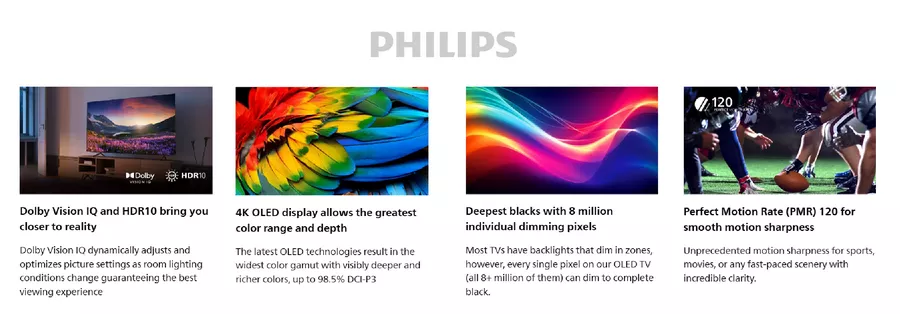
🔹Picture Quality Summary
Design
A TV’s design affects both its appearance and functionality, including bezel thickness, stand quality, and overall build materials. Some models prioritize a sleek, premium look, while others focus on sturdiness and practicality. Here’s how Vizio and Philips compare across different price categories.
Premium Class (Vizio Quantum Pro vs. Philips OLED Series)
Vizio Quantum Pro models have a bulkier design due to their full-array local dimming system. The bezels are slim, but the TV itself is thicker compared to OLED alternatives. The stand is plastic-based, functional, but not particularly premium.
Philips OLED models, in contrast, feature an ultra-thin profile with a frameless design, making them more visually appealing. The metal stand and premium materials contribute to a more high-end look and feel.
Mid-Range Class (Vizio Quantum Series vs. Philips 7900 & 7600 Series)
Both brands offer plastic-heavy builds with slim bezels in this range. Vizio’s Quantum Series maintains a sturdy but simple design, with a practical stand and minimal styling.
Philips 7900 and 7600 models feel slightly more refined, with a cleaner aesthetic and better stand quality. However, the differences are minor, as both brands use similar materials.
Budget Class (Vizio 4K Series vs. Philips 6600 & 6000 Series)
Budget models from both brands are heavily plastic-built. Vizio’s TVs are sturdier, while Philips offers thinner bezels and a sleeker design, but some models feel flimsier.
🔹Design Summary
Sound
Top-Rated Sound Quality Brands
Sound quality varies depending on speaker placement, tuning, and audio processing technology. Some TVs focus on louder output, while others prioritize clarity and spatial depth. Here’s how Vizio and Philips compare across different price categories.
Premium Class (Vizio Quantum Pro vs. Philips OLED Series)
Vizio’s Quantum Pro models include stereo speakers with Dolby Atmos support, but they rely heavily on external sound systems for the best experience. The sound is loud, but clarity can be inconsistent, especially at higher volumes.
Philips OLED models provide better audio processing with built-in subwoofers in some models, creating a richer sound experience. They offer more refined spatial sound and clearer dialogue, making them better suited for watching movies without needing a soundbar.
Mid-Range Class (Vizio Quantum Series vs. Philips 7900 & 7600 Series)
Both brands offer stereo speaker setups with Dolby Audio support. Vizio’s sound is typically louder, making it better suited for larger rooms.
Philips, however, has better tuning for speech clarity, making dialogue easier to understand. While neither delivers deep bass, Philips' models sound more balanced for everyday use.
Budget Class (Vizio 4K Series vs. Philips 6600 & 6000 Series)
Budget models from both brands come with basic 2.0-channel speakers, which provide adequate sound for casual viewing but lack bass and depth.
Vizio’s sound tends to be slightly louder, while Philips does a better job at maintaining clear voices in TV shows and news broadcasts. However, for both brands, an external sound system is recommended for an improved experience.
🔹Sound Summary
Smart TV & Connectivity
A TV’s smart platform determines app selection, navigation speed, and overall usability, while connectivity options affect how well it integrates with other devices. Some TVs focus on simple streaming, while others offer advanced smart home integration. Here’s how Vizio and Philips compare across different price categories.
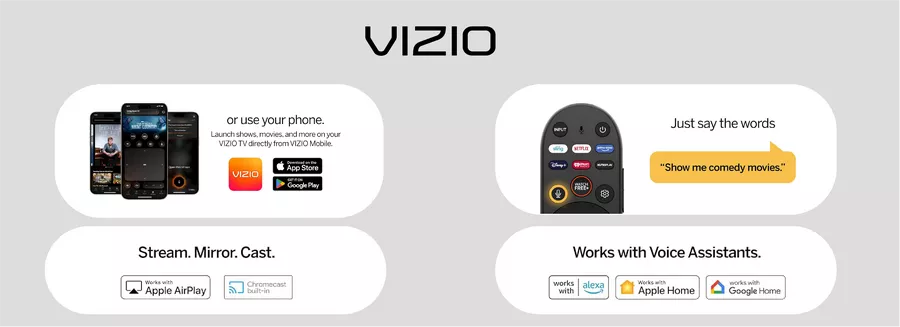
Premium Class (Vizio Quantum Pro vs. Philips OLED Series)
Vizio Quantum Pro models use SmartCast, which includes built-in Chromecast and AirPlay for easy streaming from mobile devices. However, app selection is limited, and navigation can feel sluggish compared to other platforms.
Philips OLED models use Google TV, offering a smoother experience with a wider range of apps. The interface is faster, and Google Assistant/Alexa integration is more refined, making it easier to control smart home devices.
Mid-Range Class (Vizio Quantum Series vs. Philips 7900 & 7600 Series)
Vizio’s Quantum Series runs on SmartCast, which has basic streaming features but lacks the customization and responsiveness of more advanced platforms.
Philips 7900 and 7600 models use either Google TV or Roku TV, depending on the model. These platforms provide better app support, smoother navigation, and a more user-friendly interface.
Budget Class (Vizio 4K Series vs. Philips 6600 & 6000 Series)
Vizio’s budget models still rely on SmartCast, which is functional but limited in app variety and speed.
Philips 6600 and 6000 models primarily use Roku TV, which is faster, more intuitive, and offers a wider range of streaming apps compared to Vizio’s platform.
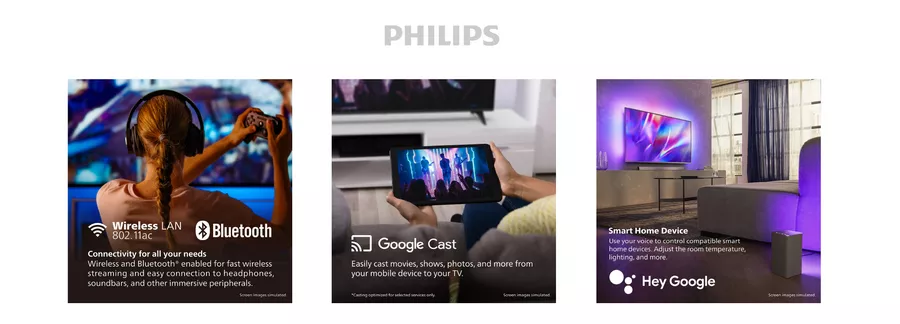
🔹Smart TV & Connectivity Summary
Brightness
Brightness is a key factor for HDR performance and visibility in bright rooms. Higher brightness levels enhance HDR highlights, color vibrancy, and overall picture impact, while lower brightness limits a TV’s ability to display bright, realistic visuals. Here’s how Vizio and Philips compare across different price categories.
Premium Class (Vizio Quantum Pro vs. Philips OLED Series)
Vizio Quantum Pro models offer over 1000 nits of peak brightness, making HDR content more vibrant and suitable for bright rooms. However, the local dimming system can cause blooming in dark scenes.
Philips OLED models focus more on deep blacks and contrast, but with a peak brightness of around 800 nits, they don’t achieve the same HDR impact in well-lit environments. While HDR looks great in dark rooms, it may feel less dynamic in bright settings.
Mid-Range Class (Vizio Quantum Series vs. Philips 7900 & 7600 Series)
The Vizio Quantum Series reaches 700-800 nits, delivering strong HDR highlights with decent contrast control.
Philips 7900 and 7600 models peak at 600-700 nits, which is still bright but slightly lower than Vizio. However, Philips models prioritize color accuracy over raw brightness, making them better suited for balanced viewing rather than extreme HDR impact.
Budget Class (Vizio 4K Series vs. Philips 6600 & 6000 Series)
Vizio’s 4K Series achieves 400-500 nits, making it one of the brighter budget options. This allows for some HDR support, though it’s limited compared to mid-range and premium models.
Philips 6600 and 6000 models reach 300-400 nits, making them better suited for SDR content rather than true HDR performance. These TVs perform fine in moderate lighting, but in bright rooms, they may appear dimmer than Vizio’s options.
🔹Brightness Summary
Smart Features
Smart features include AI-based enhancements, gaming optimizations, and unique brand-specific technologies. Here’s how Vizio and Philips compare across different price categories.
Premium Class (Vizio Quantum Pro vs. Philips OLED Series)
Vizio Quantum Pro models include basic AI-powered adjustments but lack advanced AI-driven picture and motion enhancements. The Vizio IQ Ultra+ processor handles HDR tuning, but it doesn’t match the real-time optimization capabilities of Philips' AI-powered P5 processor.
Philips OLED models use the P5 AI Perfect Picture Engine, which improves contrast, sharpness, and HDR tone mapping. The AI upscaling enhances lower-resolution content, making older shows and movies look sharper. Philips also includes Dolby Vision and HDR10+ support, delivering more refined HDR performance.
Mid-Range Class (Vizio Quantum Series vs. Philips 7900 & 7600 Series)
Vizio Quantum Series models use the IQ Active processor, which provides decent picture adjustments but lacks advanced AI-driven features. The HDR performance is solid, but motion handling isn’t as refined as on Philips models.
Philips 7900 and 7600 models use P5 AI Lite, which enhances contrast and upscaling. The 7600 Series supports a 144Hz refresh rate, making it a better choice for smooth gaming compared to Vizio’s 120Hz models.
Budget Class (Vizio 4K Series vs. Philips 6600 & 6000 Series)
Vizio’s budget models lack AI-driven optimizations, relying on basic HDR tuning for picture enhancement. While functional, it doesn’t improve low-quality content as well as Philips.
Philips 6600 and 6000 models use basic AI enhancements, improving color balance and motion clarity. While the difference isn’t dramatic, Philips’ models provide a more polished viewing experience.
🔹Smart Features Summary
Remote Control
A remote control should be easy to use, responsive, and provide quick access to key functions. Vizio keeps its remotes simple and functional, while Philips offers more variations, including Google TV and Roku TV remotes with better voice control and smart home integration.
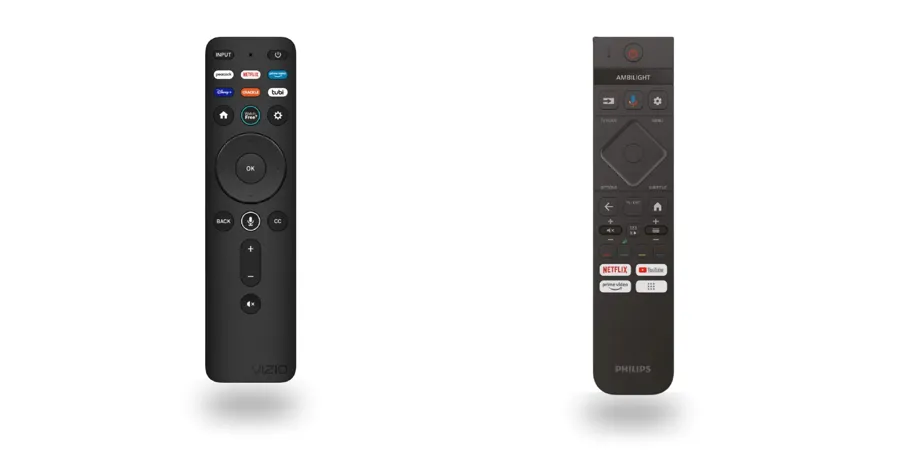
Premium Class (Vizio Quantum Pro vs. Philips OLED Series)
Vizio’s premium remote features quick app buttons and built-in voice control, but lacks backlighting and can be slow to respond at times. While it supports both IR and Bluetooth, the voice assistant integration isn’t as refined as Philips'.
Philips’ OLED models use Google TV remotes, which offer faster voice control, a better button layout, and improved responsiveness. Some models include backlit buttons, making them easier to use in the dark.
Mid-Range Class (Vizio Quantum Series vs. Philips 7900 & 7600 Series)
Vizio’s mid-range remotes are functional but basic, offering app shortcut buttons and standard IR controls.
Philips 7900 and 7600 models come with either Google TV or Roku TV remotes, depending on the model. These remotes offer better voice integration, improved navigation, and more intuitive layouts.
Budget Class (Vizio 4K Series vs. Philips 6600 & 6000 Series)
Vizio’s budget remotes are simple, with no voice control and limited functionality beyond app shortcuts.
Philips' budget models often use Roku TV remotes, which provide better app navigation and a more user-friendly design. While they lack premium features, they offer a smoother experience compared to Vizio’s basic remote.
🔹Remote Control Summary
Conclusion
Vizio and Philips cater to different audiences, with Vizio focusing on affordability and high brightness for HDR, while Philips delivers better smart features, OLED technology, and AI-driven enhancements. Your choice depends on what matters most to you—whether it's budget-friendly options, gaming performance, or premium picture quality.
Buy a Vizio TV if:
You want the brightest HDR picture for the price (Quantum Pro Series).
You’re looking for an affordable 4K TV with decent contrast.
You don’t mind SmartCast’s limitations and plan to use external streaming devices.
Buy a Philips TV if:
You prefer better smart TV features with Google TV or Roku TV.
You want OLED for perfect black levels and cinematic quality.
You value better sound, AI-driven picture enhancements, and premium design.


















